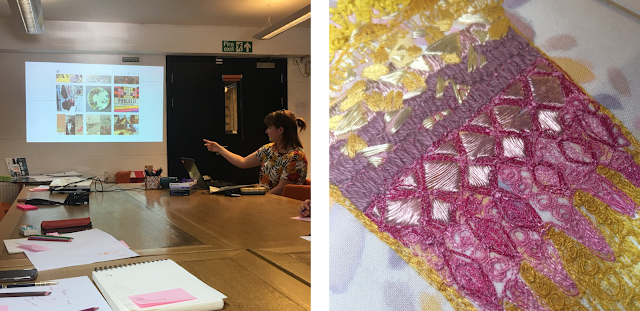Prototyping Workshop
 |
| A student is making the prototype based on Erin’s Heat Pressed Textile |
What is Prototyping?
I think it means a way to test our ideas, and the first version of an art or design object. But Kaitlyn said, ‘there are several different types of prototyping, and what we are going to learn is the first level ‘MVP’, which means the ‘minimum viable prototype’. It is the simplest we can do to test an idea.
Prototyping game
Firstly, the tutors gave us an example. It is an interesting game, similar to ‘Draw Something and Guess’. They worked in a group of three, and a sticky note with some words describing a special idea or product was stuck on Anna’s forehead. Then John and Kaitlyn tried to illustrate this idea by some materials, like masking tape and their cell-phone. They wanted Anna to guess the words “leg smart phone holder” which were written on the post-it notes, then test whether their prototype was achievable. The responses from them and Anna were the results of test.
 |
| The atmosphere of the game was very warm and everyone was immersed in it |
So, during the game, the person who prototypes can have some feelings about the idea, and the audience, who do the guessing, can also have some feelings. People can refine and revise their work based on these feelings. That is how the prototyping works.
Next, we had a go at prototyping too and got sticky notes with some conceptual products or ideas. One of the groups got “apps for old people to get boyfriend and girlfriend” and another “hat that has built-in headphones”, which are difficult to express without language. They try to find appropriate material to make the prototype quickly and illustrate the prototype to their partners.
 |
| Prototype making process required some serious 'brain acrobatics' |
After that, we started making our first prototypes. We were asked to draw some sketches of our ideas about the Archives object quickly, because previously we had finished some research on our objects. With the research materials, we went into different aspects, like color, culture, technique, function, pattern, etc., anything relevant to our objects. Then we chose three of the sketches to make a prototype.
For example, one group who had chosen three strips of cloth from China, made a collar to show the strips’ function, a rose to show the embroidery pattern and a newspaper curtain to show the contrast of culture. Cassie and Simba’s group made a connected eyebrow mask, showing culture and makeup of ancient Egypt, because their object is an Egyptian pottery fragment, which has the pattern of connected eyebrow people. Joseph’s group made a colorful and cute shaver based on the embroidery of the ice-cream because they wanted to show beautiful, bright and blithe color of it, and also use a similar shape.
Then tutors discussed our prototypes, everyone also shared their opinions with each other. For example, John said the newspaper curtain was interesting because of the contrast of old and modern, natural and artificial. He thought we can go further with that.
During the class discussion in the afternoon, we talked about the session. A student thought this session taught us a method about how to apply our ideas in a practical way and it is challenging to realize the thought by actually making something. Other people think Kaitlyn and John’s opinions are helpful for our divergent thinking. For example, in the strip project, students can explore more about the contrast, not only have a superficial discussion about the visual impact for example, but go deeper and discuss for instance spirit and feminism.
We also summarized what we had learned so far: when we start a new project, whatever it is an artwork or design, we firstly do primary and secondary research, then come up with ideas based on the research. After that, we make a prototype based on the ideas, test it and refine it.
 |
| Kaitlyn, John and the students are discussing the prototype related to the textile |
***
This blog post was written by Congcong Liang and Yining Fang, and edited by their classamates and tutors. Congcong is going to study MS in product design engineering and says 'My life is brilliant; my love is pure' while Yinning is an Interior designer and her motto is 'Be who I am; this is the first step toward becoming better than I am'.
***
Many thanks to Kaitlyn and John for the inspiring workshop!


Comments
Post a Comment